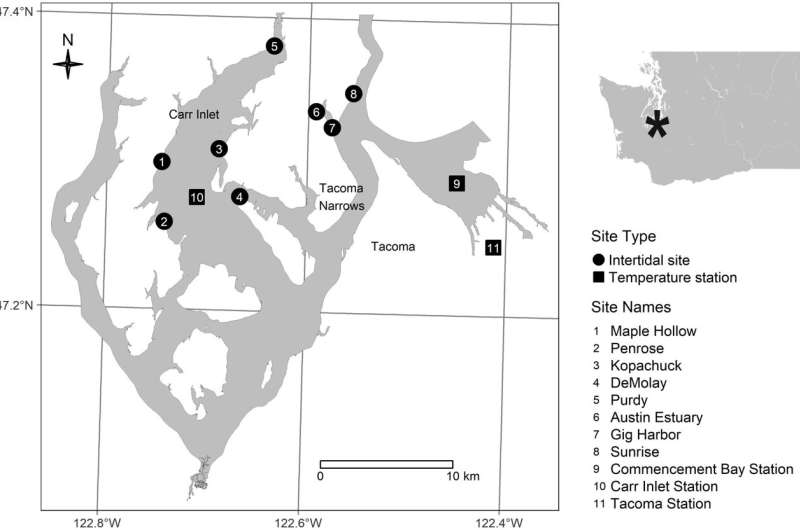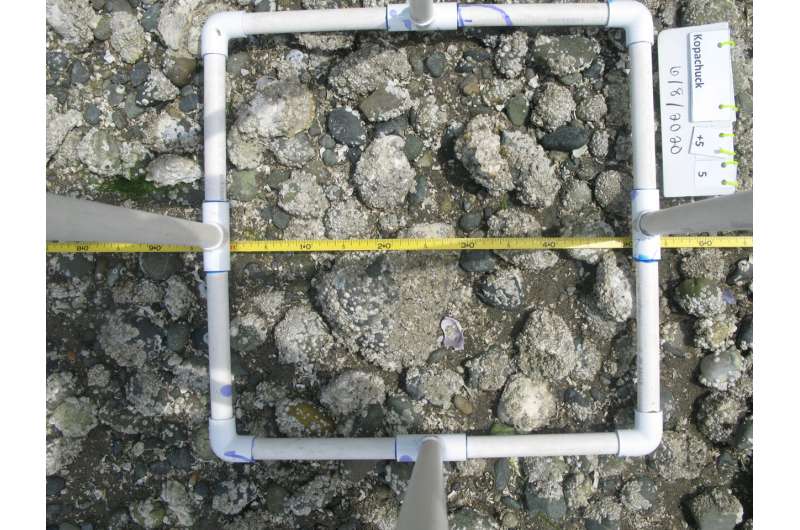March 26, 2024 feature
This article has been reviewed according to Science X's editorial process and policies. Editors have highlighted the following attributes while ensuring the content's credibility:
fact-checked
peer-reviewed publication
trusted source
proofread
Invasive Pacific oyster proliferation during Blob marine heat wave portends similar events as seas warm

Pacific oysters, non-native to the United States but farmed in the U.S. for aquaculture, are an invasive species. During the Pacific Blob heat wave in the mid-2010s, as sea temperatures in Washington state's Puget Sound rose to 3°C above average, the species proliferated in the wild, and species recruitment for the period 2012–2020 peaked in summer 2015.
In the absence of any studies on effects of this marine heat wave on the populations of Pacific oysters in this area, a research team from the University of Washington, Pacific Lutheran University, and Harbor WildWatch has explored this topic. Their work is published in Frontiers in Marine Science.
Pacific oysters (Magallana gigas, formerly Crassostrea gigas) are native to the Pacific coast of Asia. Farming of this species began in 1919 in south Puget Sound and is now substantial across the region. Recently, wild populations have begun to establish in the area, but "we do not yet know how oysters perform outside of aquaculture on rocky shores of south Puget Sound," the researchers emphasize.
Pacific oysters usually spawn when the sea temperature is approximately 20°C. Eggs are then fertilized, and for the next few weeks, the resulting larvae remain loose in the water. Finally, they attach to a hard underwater surface such as existing shells, piers or rocks; this is the process of recruitment.
An approximate temperature of 27°C best supports this activity, but earlier research shows that it can also occur at lower temperatures. A 2009 study found a survival rate of more than 80% among larvae in water at 17°C.
However, inflow from the Strait of Juan de Fuca (to the north) creates cool water temperatures in Puget Sound. "Water temperatures in south Puget Sound have not historically achieved the temperature threshold for spawning; during our study period, the mean summer water temperature from all recordings used was 14.5°C, much lower than the typical spawning threshold of 20°C," write the researchers of this new study.
They sought to investigate:
- The number of oyster cohorts in south Puget Sound over a ten-year period;
- A possible correlation between water temperatures and oyster recruitment within the studied areas and time period;
- Whether the higher water temperatures resulting from the Blob encouraged oyster reproduction;
- Possible differences in density and shell size among study sites after the oysters' initial recruitment.
The team predicted that the higher water temperatures would yield higher recruitment, and that they would observe varying oyster population dynamics among the study areas.
Effects of the Blob
The Blob marine heat wave began off the North American Pacific coast in winter 2013–2014, and reached the coast—including the Salish Sea, of which Puget Sound is a part—during 2014. It lasted until 2016 and raised sea surface temperatures approximately 3°C.
Among its other consequences, the paper notes, were sizable blooms of phytoplankton that spread a neurotoxin, changes to the composition of California kelp forest communities, and the mortality of certain fish larvae.
Beginning in 2013, the research team conducted twice-yearly (winter and summer) counts of wild Pacific oysters at eight beach sites—five in the Carr Inlet to the west, and three in Tacoma Narrows to the east—within south Puget Sound. To accomplish this, they placed quadrats randomly at each sampling site (not in existing oyster beds) in the mid- and upper-intertidal ranges and maintained them within a few meters throughout all the study's sampling dates.

Notable results
On each sampling date, the team counted the oysters in each quadrat, measured the heights of their shells, and determined the mean oyster density at each location and tidal elevation.
Interestingly, throughout the study period, the team did not find any Pacific oysters at any of the three eastern sites, but their study notes that oysters appeared at all five of the western sites beginning in 2016 (after having recruited in 2015). Recruitment occurred at these five western sites again in 2017, 2019 and 2020.
At these western sites, the researchers found a mean summer water temperature of 15.7°C, while the mean summer water temperature at the eastern sites was 14°C. The warmest water temperatures at the western sites also occurred from 2014 to 2015.
The researchers observe, "Higher summer water temperatures in our study were correlated with higher recruitment. Oyster recruit density in our study was estimated to increase by a factor of 5.67 per additional degree C in summer water temperature."
However, they did not find any correlating growth trends, noting that environmental factors might have played a role in the varying oyster shell heights they recorded.
The big picture
It has been predicted for many years that climate change will generally support species invasion, and based on these results, such species will include Pacific oysters. "Pacific oysters globally are expanding their range poleward as water temperatures warm," write the researchers.
But importantly, their findings from the normally cooler Puget Sound "suggest that warming may not simply move species poleward but also into regions kept cool by deep water intrusions from the coast.
"We can expect that in areas where low temperatures have previously prevented the establishment of non-native species, increased temperatures in the future will enable species invasion," they conclude.
More information: Emma Lee Beck et al, Wild populations of Pacific oysters (Magallana gigas) emerge during the blob heatwave in south Puget Sound, Washington USA, Frontiers in Marine Science (2024). DOI: 10.3389/fmars.2024.1292062
Journal information: Frontiers in Marine Science
© 2024 Science X Network




















